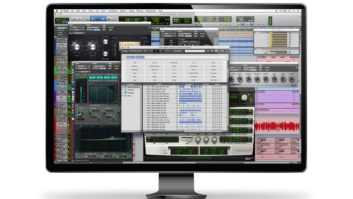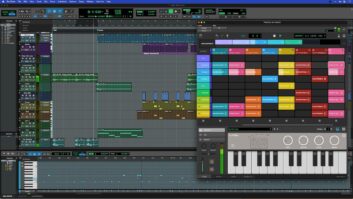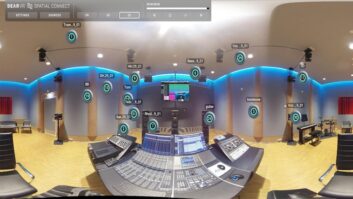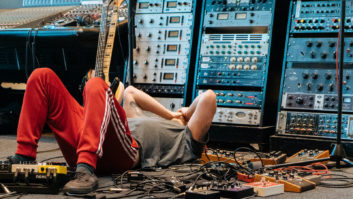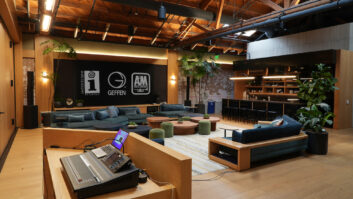As a writer who has spent much of the past 20 years interviewing producers and engineers about recording projects, I’ve been in the thick of the great analog vs. digital debate for most of those two decades. It’s an issue that simply refuses to go away. As each new digital recording medium reared its head — whether it was the early PCM machines or DAT or DCC or MiniDisc or ADAT or 3348 — there was always a chorus of supporters ready to embrace the new technology, and an equally vocal group condemning it. Over the years, many engineers have learned to strike a balance in their work, using analog and digital gear together to get the best of both worlds. And the process of natural selection has always been in effect: DCC was a miserable failure; MiniDisc never became the popular medium Sony had hoped for, though it has found its niche; DAT has been somewhat successful, widely used as an alternative to half-inch analog; MDMs had a few years of very strong sales; and tape-based digital machines are still favorite tools of a number of top engineers.
But it’s safe to say that nothing has been as widely accepted as the later generation versions of Digidesign’s Pro Tools. In a matter of just a couple of years, it has achieved a remarkable penetration throughout the industry — in music recording, post-production, sound effects generation — and it has become nearly omnipresent, even winning a technical achievement Grammy Award. Yes, there are still many engineers out there who haven’t given in to its seductions, who remain staunchly anti-digital; or if they like digital, prefer other platforms, including Emagic Logic Audio, MOTU Digital Performer, Steinberg Nuendo and others. But it is becoming downright rare to encounter a major project that doesn’t involve Pro Tools in some capacity, and that’s probably just going to increase as the technology gets better and moves into even higher bit rate recording. I knew the takeover had really happened when I interviewed Andy Smith, the engineer on Paul Simon’s last album, You’re the One, a year-and-a-half ago. Asked about the recorders he’d used on the project, he became very quiet and then, sheepishly, noted, “Well, I’m not sure I want people to know we did it on Pro Tools.” If there was a stigma about it then, that has all but disappeared. Indeed, there is an entirely new class of audio professionals now: the “Pro Tools engineer.”
Recently, we spoke with four top engineers about the medium and about how the job of mixing has been affected by the profusion of Pro Tools projects coming their way.
DAVE PENSADO
The L.A.-based Pensado is one of the top R&B and pop mixers on the scene today (see “Mix Masters,” September 2002), having scored hits with the likes of Christina Aguilera, Brandy, Brian McKnight, Destiny’s Child, Pink and many others. When we spoke, he was working on mixes for Boyz II Men.
“I’m probably one of the few guys who really doesn’t care about whether it comes to me on Pro Tools or 2-inch or what-ever,” the always-outspoken engineer says. “I’m a big believer in whatever format it comes in, leave it. I don’t believe that if it comes in on analog tape, transfer it to Pro Tools, or if it comes in on Pro Tools, convert it to analog tape. I hear people saying, ‘Let me transfer this digital to analog so I can make it warm.’ To me, warm is another word for ‘dull.’ Warm is not really a recording concept, and all these guys that are still shooting for warm just sound dull on the radio when they follow a mix that’s ‘not warm.’
“There are exceptions,” he continues. “If it’s in a digital format, I might change it over, like if it comes in on DA-88, I’ll take it AES into Pro Tools. But I’m not a big believer in any analog conversions other than the one that goes from Pro Tools into my SSL.
“The other thing I’ll do sometimes is make a Pro Tools copy of the analog tape, but use it for only visual reference. I love the convenience of being able to see the waveform. Say, I’ve got one cymbal crash on a track. I don’t have to listen to the whole track to find it. I can see it visually in Pro Tools, and then, should I need to retrigger or edit, then I’ll use the Pro Tools track to do the triggering, but I’ll keep my sound actually off the analog.”
Pensado says he has no time for the analog/digital argument: “I can’t believe there’s a bunch of guys out there still debating whether digital is going to fly or not…It flew; get over it! It’s here, it’s great!
“As I’ve said before, there are 52 cards in the deck; why not use them all? If you feel that you can get a fatter kick drum sound off of a 16-track head stack running at 15 ips, do that. If you feel you can get a better sound out of Pro Tools, do that. I’m constantly running analog and then I have that copy in Pro Tools, so it’s really easy for me to compare them. And the fact is, there’s really no difference. If you can’t make digital sound good, it’s because you have too bad an attitude to make it sound good.
“I remember reading a Rupert Neve article a few years ago that said 16-bit digital is causing children to become delinquent! So maybe we better accelerate this move to 192k! I mean, Rupert Neve is undeniably one of the greats of all time in the audio field, but what that points out is the mythology involved with digital and the lack of understanding about what a benign format it is.
“Mostly, the difference between analog and digital is a function of the person engineering it. By the time I’m through with a drum sound, it doesn’t matter what it started with, because if I don’t have all the components in the sound, I’ll add ’em myself. For example, let’s say I’m missing that last octave, from 80 to 40 [Hz]. I’ll add it myself. I’ll add a sine wave that’s in tune with the track. Or, let’s say I’m given a poorly recorded snare and I’ve got more hi-hat in my snare mic than snare: I’ll find a good snare without too much hi-hat in it and sample that and run that back in, and if I still don’t have enough attack, I’ll take the front part of a sample — like just the instant when the stick hits the head of the drum — and I’ll add that back in. So by the time I’m done, it’s better than digital or analog.
“The whole point of mixing is to not be limited by what you’re given, but only be limited by your imagination. My philosophy is don’t sit there lamenting the sound you’re given. Fix it. That’s your job.”
Pensado usually prints his mixes to Quantegy 499 tape (which he endorses, along with Digidesign and SSL) and to DAT. He says the mastering engineers he works with have been largely complimentary of his Pro Tools mixes.
Asked about the quality of the recordings that have been coming to him since the proliferation of Pro Tools, he says, “From an engineering standpoint, it’s not great. From a creative standpoint, it’s better than ever. But I’d rather work with someone who’s really trying new things and failing than someone that plays it safe and gives me a bunch of sterile tracks. The beauty of Pro Tools is that it opened the music field up to so many kids who didn’t have access to it before. It was only 25 years ago that if you couldn’t hire live musicians, you couldn’t be a producer. One of the reasons people hated drum machines so much is that it gave access to a lot more people and made the little club bigger. Pro Tools has given opportunity to a lot of people, and that’s going to be very good for our industry in the long run.”
BOB BROCKMAN
New York-based engineer and producer Bob Brockman was a recent nominee in the Best Engineered Recording category for Laurie Anderson’s fine Life on a String CD. He’s probably best known, however, for his work with R&B hitmakers such as Mary J. Blige, Babyface, Toni Braxton, the Notorious B.I.G., The O’Jays and many others. Along with his partner in NuMedia Productions, Yaron Fuchs, he’s currently toiling over the much-anticipated album by Boston’s Wicked Queen.
As a top mixer, Brockman receives tapes that are all over the map in terms of quality, “everything from stellar-sounding stuff to absolute crap,” he says. “And it has to do with who’s involved in the earlier stages. Unfortunately, I believe the age of the great recording engineers is over. With the corporate nature of the record business and the cost cutting, a lot of producers I work with engineer their own records, and a lot of artists engineer their own records, too. Even the Laurie Anderson record, a lot of it was done by Laurie, because she couldn’t afford to hire an engineer to work for a year-and-a-half on her record. And, of course, you have more people recording to Pro Tools because it’s cheaper than working with 2-inch.
“You don’t expect an artist who’s recording their own stuff to be totally on top of the recording aspect of it. But I’ve found that one of the things that ends up happening in the case of Pro Tools is you have source material that may be very interesting to listen to, but which is often recorded at a really, really low level; it’s 10-bit or 8-bit or even 6-bit. When you have a lower level recording at 24-bit, the lower the level gets, the lower the bit resolution. That’s just the way PCM works. If you don’t record a super-hot level, then you’re not getting all the bits in the word resolution, and, consequently, it can sound pretty degraded.
“So that’s a problem I find with some projects that are from home studios, started on ADAT and maybe bumped across to Pro Tools: When you’re doing a D-to-D transfer, you don’t necessarily have the option of increasing the word size. If it’s recorded soft to ADAT or soft to Pro Tools, you’re pretty much stuck with what you get. So as a mixer, you end up trying to recover it by putting it through tubes and whatever analog processing you can.
“My studio [NuMedia] is set up so that I have 64 inputs into a Harrison Series 10, and we have 48 outputs from Pro Tools, and we have tons and tons of outboard stuff from Manley and GML and API and Neve — LA-4s, LA-2s, LA-3 — it’s a pretty thick rack. I put everything across everything,” he says with a laugh. “We use the Fatsos, we use Distressors; anything we can to try to generate more warmth and more analog feel.
“I’m old enough that I mixed for about 15 years off analog tape through analog consoles before the advent of Pro Tools. But in the past 16 months, I haven’t mixed one record on analog. Even rock ‘n’ roll records that started out on analog got bumped to Pro Tools, and we ended up mixing that way. Digidesign has become the de facto industry standard.”
And how does Brockman think it sounds? “I don’t think it sounds great,” he notes matter-of-factly. “You can’t argue about the ease of editing, and the playlists, the tuning and moving in time — all these things you can do to smooth out a vocal performance that you were never able to do on analog tape. There’s a great deal of power from a producer’s standpoint working in Pro Tools. I just wish it didn’t sound so harsh. Sonically, it’s not all the way there for me.
“I’ve heard records that were mixed off analog, or records that were remastered off analog, and even on a 16-bit CD, and you can really hear the difference. There’s a marked difference, but these days, no one seems to care. If it’s delivered that way, that’s the way you have to mix it.
“On this Wicked Queen record, I’ve really gotten into using the Fatso, which is a tape-saturation algorithm compressor box. I’m recording everything through it — guitars, lead vocals. I’ve recorded vocals with it and without it to Pro Tools, and the level of clarity and penetration you actually get from the source material is really markedly different. It adds a lot.”
Except for his work on Christina Aguilera’s Mi Reflejo CD, which was digital from start to finish, Brockman still likes to mix down to half-inch, “to put the mix across analog heads to get a little dither into the mix. It’s never as gratifying for me to mix off the 2-bus of Pro Tools as it is to bring up everything separately into a big console and mix it onto half-inch. I hear the difference.” His current tape of choice in that regard is BASF 900, “which has great clarity but also low-end saturation. When you go to half-inch, you really hear how the low end integrates, as opposed to 24-bit DAT, which is pretty much exactly what’s coming off Pro Tools.”
Like many mixers, Brockman has also worked on hybrid projects that combine Pro Tools and 2-inch analog. “On this new Gabriella Anders album, where she’s working with The Roots rhythm section,” he comments, “the bass, drums and guitar were cut to 2-inch and then the vocals and the percussion and keyboards were done in Pro Tools. So that was a situation where we were running Studer 24 and Pro Tools was chasing. The producers really wanted to maintain that analog sound for the rhythm section.”
Brockman also laments the fact that Pro Tools is not compatible with some other popular formats, such as Logic Audio. “Logic plug-ins are great,” he says, “but, unfortunately, they don’t work with the DAE engine. What ends up happening when you have to convert the output engine from, say, MOTU to DAE, is that the plug-ins get blocked out. So if that’s a cool delay or chorus and it’s part of the production, you can lose it. Also, the plug-ins sound different played out through a MOTU engine vs. a Digi engine. That’s a big problem.”
He concludes with a paraphrase of Rodney King’s famous remark: “I wish everyone would just get along.”
JACK JOSEPH PUIG
For the past several years, Jack Joseph Puig has been one of L.A.’s first-call mixers. Working out of his own fabulously equipped room at Ocean Way (you loved it on the cover of the October 2000 Mix), Puig has worked with a wide array of artists, including No Doubt, the Black Crowes, Collective Soul, Five for Fighting, Green Day, and many, many others. When we spoke recently, he was in the midst of doing mixes for Sheryl Crow and the Counting Crows.
“Most of what I get these days are Pro Tools sessions, and what I’ve done is I’ve created a sheet that goes out to people before they send me the Pro Tools information,” he says. “On that sheet is a very detailed explanation of what we want: For example, we explain that it has to come condensed to 64 voices. We don’t want it to come with more than 64 voices, because then we have the headache of trying to figure out what everything is and how we’re going to deal with it. We also ask people to give us a rough mix of the session. So in Pro Tools, you have to leave two voices [out of the 64] to print to.
“We have a lot of issues with labeling,” he continues. “I’m not someone who wants to spend his time hunting for stuff. I generally demand that either the producer or someone from the band is around to help me find things. With analog, you usually only have 24 choices, or say, 48 choices; but with Pro Tools, there’s almost an unlimited number of choices. You have these layers, and which is the right performance? That’s a real, real problem. The problem with having to go through all that is expensive and you’re taking time that should be used to mix the record looking for stuff.”
Like Brockman, Puig believes that “the sound of analog, without a doubt, is still superior. There’s no question about it. I’ll get projects in and throw the faders up and it’ll sound great, and I’ll say, ‘How did you record this?’ ‘Oh, we did it on 2-inch first.’ Every single time.
“I just did a test myself: I recorded two sides for a band on Maverick called Ebo, and what I did was I recorded simultaneously to 2-inch and to Pro Tools. And the difference was dramatic. I could pick out the better-sounding analog one with my eyes closed — that one, that one, that one; never missed it. It was really telling. And, unfortunately, all these plug-ins that are analog simulators basically just take off the highs. They just make it woolly and dull. Their concept of what analog does is not right in my opinion.”
Does transferring a 2-inch tape to Pro Tools affect the sound much? “The Pro Tools holds it as well as it can. It’s never the same as playing it from analog, but when we made the jump to 24-bit Pro Tools, it at least became do-able; it became acceptable. Obviously, if you’ve got a rack of Prism or D/D converters, which are quite expensive, it becomes that much better, but when we eventually make the big jump to [Pro Tools] 96 and so on, it’s going to be amazing.”
All Pro Tools sessions are not created equal, Puig has learned, and when he has multiple sessions coming in recorded at different studios under different conditions, he notes, “The clock is extremely important. The length of the cables that carry the superclock to the 888 and the quality of the BNC connectors are extremely important. If you get the cables the right length, which basically means all the same length, and you get a great BNC connector and a great clock, that alone makes a big difference. What really sounds great is if you have a Sony HR machine and you leave it in ‘input’ and then use it for the converters. That’s awesome, but expensive.
“One of the most important things about all-digital stuff — whether it’s 3348 or Pro Tools — is the kind of level you’re able to put on there, because, obviously, you want to use all the bits. The kind of level the analog console feeds is really too much for it sometimes. And that’s one of the biggest issues of digital and analog meeting on a daily basis in professional recording studios. What I do is align my Pro Tools systems for a lower level. I used to do that with other digital recordings that were really hot, and even analog once in a while. Because if you get the front end too hot, you’re f***ed; you run out of headroom.”
Puig says that about 85% of the work that comes through his door now is on Pro Tools. “There are people holding out with 3348s — some old-timers — but that’s not going to last. You can’t do half the stuff you can with Pro Tools, and now it’s getting to the point where people are used to coming to the session and saying, ‘Can we move this, can we do that? Can we fix that?’ And all those things are nearly instantaneous with Pro Tools. It’s to the point now where you’ve gotta learn it; there’s no way around it. As an assistant engineer and an up-and-coming engineer, if you don’t know how to run Pro Tools, get out! ‘Cause it’s not going away.”
Puig believes that the combination of analog gear he favors and the new digital plug-ins has actually expanded his sonic palette, allowing him to make better records. “What I’m discovering is that there are digital equalizers and compressors that, when married with the analog stuff, sounds great. Like the way an L1 would talk to an LA-2 is different than how a C1 talks to an LA-2, etc. The kind of curve that it does, maybe combined with a 550A or combined with a Pultec or whatever, creates a sound of its own that can be really cool. I like to look at all the possibilities.”
NICK LAUNAY
When we caught up with producer/engineer/mixer Nick Launay, he was finishing the tracking for the latest disc by American Hi-Fi at Sunset Sound, and was getting ready to move over to Atlantis Studios to mix the project on the SSL 9k there. Then it was off to Melbourne, Australia, to continue work on Nick Cave’s new CD. That’s the way life is for the globe-trotting Launay: Though English, he works all over the world, has a home in L.A., but also seems to have a special affinity for Australian bands. Among the groups he’s worked with are INXS, the Living End, Midnight Oil, Gang of Four, Killing Joke, Kate Bush, Silverchair and Public Image.
Launay is basically still an analog guy: He likes to record bands, as a whole group, to 2-inch. That’s how he’s making the American Hi-Fi album. Still, he notes, “I love Pro Tools, and I use it a lot. In the case of [American Hi-Fi], they’ve got an incredibly good drummer and they’re all great musicians, and there was no need to go in there and move kick drum hits and all the things that Pro Tools lets you do. We actually thought of doing the basic tracks and then going to Pro Tools, but we decided not to; there’s no need to. It’s nice to be able to say that.
“I’m always open to new things, but I always put sound first,” he adds. “I do find it extremely frustrating that Pro Tools doesn’t sound better than it does, and that to my ears digital doesn’t sound very good — still. What is it, 18 years now? Those who think it sounds great haven’t used analog, or if they have and they really can’t hear the difference, they perhaps need to change careers; the difference is enormous.
“The problem that I hear with Pro Tools, and with digital in general, is that it’s very shallow; there’s not that much dimension to it. I don’t think people really looked into that aspect of it. I think they put their tones up and see the frequency response, and they try to get it technically correct, where what they should be doing is trying to understand why when you record on analog, it sounds more three-dimensional — even if you’re dealing with a mono signal. It has something to it that has depth that you don’t get on digital, and I frankly don’t know what that is. But my ears hear it.
“With digital, everything sounds like it’s in two dimensions; everything sounds like it’s right up close, even if you’ve got a drum sound with a lot of drum ambience. When you record it on analog, it feels like you can feel the room; there’s a depth and warmth that’s very pleasant to listen to. Something gets lost when you go to digital. The sonic depth is missing.”
To compensate, when he does mix Pro Tools sessions, “I do whatever I can to make it warmer and to bring in some of that depth. I might put the whole thing through a Fairchild at the end. I’ll use as many Pultecs and Motown EQs as I can. I try to use the best A-to-D converters I can find. If I can get a hold of them and I have the budget, I’ll use Apogee converters. I think they’re the warmest. They might take a little punch out, but that’s easier to get back in mixing than the warmth.
“I never record directly to Pro Tools; I never have. I like to set up a band all in the same room, playing off each other. If they’re a guitar band and they’ve got two guitar players, well, they have to play directly to the drums at that time; it’s like a live performance. We do takes until they get it right. Then I’ll slice on 2-inch; I’ll edit between the best takes. The end result might be a 2-inch multitrack that might have up to 30 edits on it, just to get the best performance.
“Once I get the basic band takes on 2-inch, sometimes I’ll transfer it to Pro Tools for overdubs and vocals…and we just suffer the loss,” he says with a chuckle. “I’ll make slaves in Pro Tools or I’ll mix the 2-inch to stereo guitar pairs and drum pairs, etc., and then continue in Pro Tools, doing overdubs and vocals. Then, at the end of the day, I’ll sync the two up and I’ll play my original backing band track off analog. That’s the way I’ve done the last five or six albums.”
Though he generally engineers and mixes the albums he produces, Launay is not shy about getting help with the Pro Tools work. “When I started getting into Pro Tools a few years ago, I thought, ‘This is crazy. I’m staring at a screen all day. All the things I love about making music are not there any more. The capabilities of this incredible piece of equipment are fantastic, but I’m beginning to lose track of what we’re really trying to do here.’ So I decided I should employ a Pro Tools engineer, and that was a really good decision for me. It lets me spend my time doing what I want to do and what I do best — concentrating on the song and getting the best performances.”
Blair Jackson is Mix’s senior editor.
